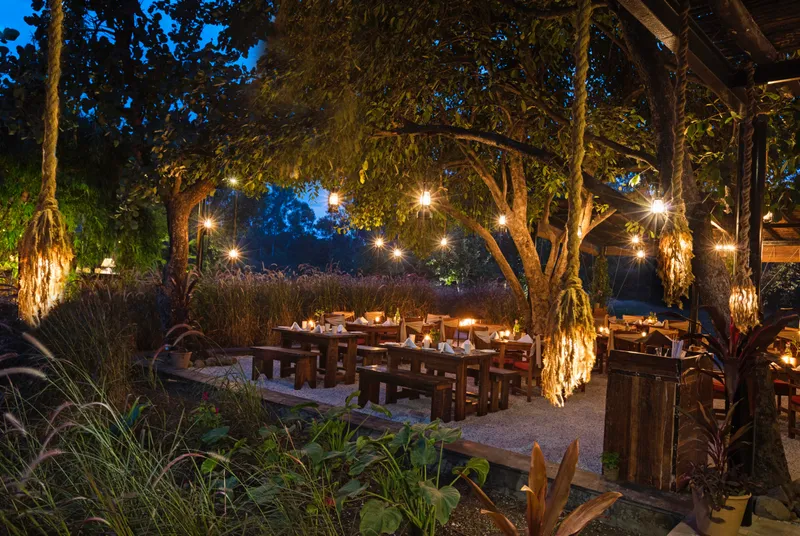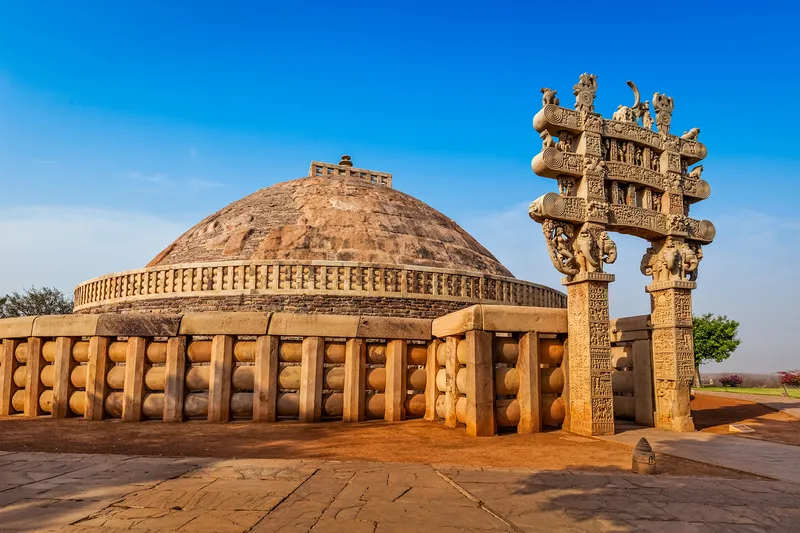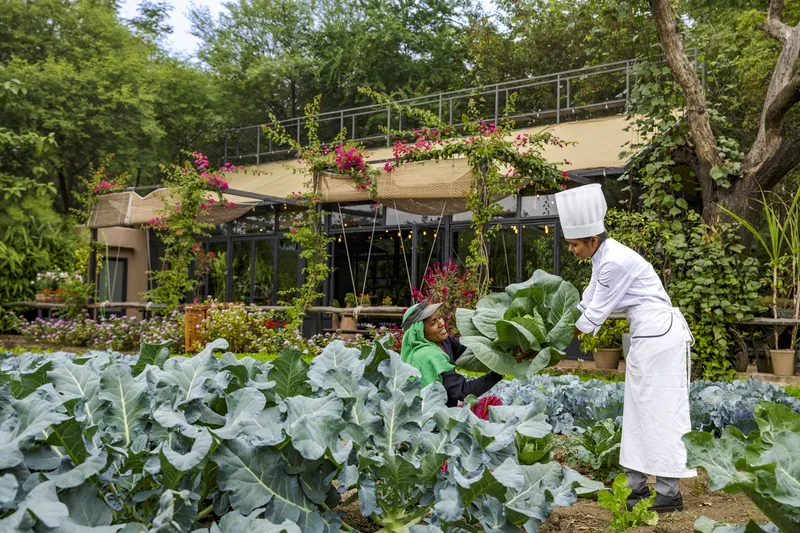History meets Nawabi hospitality and serenity at Bhopal’s Jehan Numa
A visit to the Jehan Numa Palace and the Jehan Numa Retreat in Bhopal lets one not only indulge in Nawabi hospitality and cuisine but also find historical sites along the way.
Stay. Eat. Re(un)wind.
Bhopal, the capital of Madhya Pradesh is a city of endless stories. My travel story began at the Jehan Numa Palace, with pit stops at historical sites, and ended at the Jehan Numa Retreat for some bel far niente or “the sweet joy of doing nothing”.
Live (and eat) like a queen

A view from the swimming pool at Jehan Numa Palace
The Jehan Numa Palace built by General Obaidullah Khan in 1890, the second son of Nawab Sultan Jehan Begum is perched on Shyamla Hills, with a view of the entire city. It was converted into a heritage hotel and opened to guests in 1983 by the General’s grandsons, Nadir and Yawar Rashid.
A rich historical timeline adorns the walls of the corridors at Jehan Numa Palace.
My first history lesson in Bhopal began with a museum walk that took me back in time to the reign of the Begums of Bhopal.
The four Begums of Bhopal—Qudsia Begum, Sikander Begum, Shah Jehan Begum and Sultan Jehan Begum—ruled the princely state between 1819 and 1926, and were well-known for their progressive and cosmopolitan outlook.
Nawab Sultan Jehan Begum, after whom the palace is named, was a strong advocate for women’s empowerment. She built an art school for widows and destitute women, was President of the Muslim Ladies’ Conference, and supported the conservation and preservation of the Buddhist stupa at Sanchi. These are showcased through photographs that date back two centuries.
The Jehan Numa Palace’s architecture is a mix of British Colonial, Italian Renaissance, and Classical Greek. Bougainvillaea vines and champa trees are distinct in the lush green that envelops the property.
True to its aristocratic heritage, the rooms are huge and the balconies open to beautiful views of trees or the riding track. The hotel has 100 rooms which includes six suites.
Interestingly, the Jehan Numa Palace attracts a sizable number of corporate clients, who visit Bhopal for government-related and other work.
Faiz Rashid, Managing Director of the Jehan Numa Group feels the property has been built more as a leisure destination.
“We want to showcase it as an experiential hotel where guests come to experience and relive history. We are trying to also make it leisure-focused as we believe Bhopal is a great destination for holidays, especially long weekends for people looking for newer places to explore,” he says.
Rashid explains that the property built by his great-grandfather, the general, recreates diverse experiences, whether it’s his love for horses, the “green views” from his room, and also importantly, the food.
Last year, the hotel introduced a bespoke dining concept, “The General’s Table” set under an old mango tree in the courtyard.
The beautiful table setting under the stars, with lilting strains of the flute takes one back in time with an eight-course menu of royal recipes, and according to Rashid, is reminiscent of General Khan’s wedding dinner.
Here you will find delicacies like palak dahi ka shorba (spinach and yoghurt soup), galouti kebab (minced meat kebab), baingan ki burani (eggplant curry), Bhopali machali korma (a fish korma), Rampuri chawal (a rice dish), and Bhopali yakhni pulao (a flavourful pulao cooked in mutton or chicken), all painstakingly recreated using original handwritten recipes preserved in the family palace. Most of these recipes are over a 100 years old, and were served during royal dawaats and weddings.
Meditate in solitude

Dine under the stars at the Jehan Numa Retreat
Next on the itinerary was Great Stupa at Sanchi, a UNESCO heritage site, a one-and-a-half-hour drive from Bhopal. We only stop five minutes before the historical site, at a yellow line and board marking the Tropic of Cancer.
The Sanchi Stupa, a Buddhist complex commissioned by Mauryan Emperor Ashoka houses sculpted monolithic pillars, sanctuaries, temples, and viharas. The guide is a treasure trove of information and the visit turns into a history walk as he explains the history behind each structure and how it has been preserved.
For the most part, the place is serene, only punctuated at times by a tourist holding a 200-rupee note (which has the motif of the Sanchi stupa on the reverse) to take photographs against the backdrop of the monument.

The Great Stupa at Sanchi
After a long but interesting history lesson, we drove to the Jehan Numa Retreat, a beautiful getaway located on the outskirts of Bhopal and a stone’s throw from the Van Vihar National Park and Zoo. It is green all around and the “unwind” part of the trip has begun.
If you want to relax, away from the hustle and bustle of the city, this is the place to be. My room had an outdoor deck —a perfect setting to count the stars, sip on a cup of coffee, and listen to birdsong. The Retreat takes its “one with nature” concept seriously—there is also an open-air outdoor shower attached to every room.
The Retreat is a 28-room boutique resort and the cottage clusters are named after birds–Francolin, Jacana, Heron, Hornbill, Lapwing and Kingfisher.
My dinner was Under The Jamun Tree. It was an opportunity to taste an experiential Bhopali menu that recreates “The Lost Recipes of Central India”. It featured dishes like shorbha pubhar (a vegetable broth with fresh ginger, spinach and coriander); kees ki tikki (spiced corn tikki crumbed and fried); Junglee maas (mutton braised in ghee, onion and red chillies); subz miloni tarkari (spiced mix vegetables), dhungar dal makhani (black lentils simmered overnight) and topped with delicious desi gulab kheer made from fresh roses from the Retreat’s garden.
Chef Jeewan Singh Rawat, Culinary Director at Jahan Numa says, “Recreating these lost recipes has been both challenging and rewarding. Sourcing traditional ingredients has become difficult, as some are no longer widely available, but we have worked closely with local suppliers to maintain the integrity of the dishes. While presentation tweaks have been made to appeal to modern palates, the essence of these recipes remains unchanged.”
A stroll through the park

Fruits, herbs and vegetables are grown at the Jehan Numa Retreat
Next on the travel list was Van Vihar National Park and Zoo, a walking distance from the Retreat.
Van Vihar is a national park, zoological garden, a rescue centre for wildlife, and a conservation breeding centre for tigers, barasinghas, and vultures. It’s also a stroller’s sanctuary with views of the lake on one side and the animals and birds on the other.
Another option is to visit the Bhimbetka Caves, a UNESCO-heritage site consisting of seven hills and over 750 rock shelters over 10 km, featuring cave paintings dating back to the Paleolithic, Mesolithic and historic periods.
Lunch was at The Green House Bistro, a restaurant that runs on a farm-to-fork concept, sourcing vegetables, fruits and herbs grown on the property.
If it’s wilderness stays you are interested in, the Jehan Numa Group offers the Reni Pani Jungle Lodge at the Satpura Tiger Reserve, and the Bori Safari Lodge at the Bori Wildlife Sanctuary.
At the end of three days, I had savoured every element of the luxurious escape to the fullest—culture, food, history, and hospitality. And, understood that where there is no “hustle” in your head, time can stand still and allow peace to wash all over you.
Edited by Affirunisa Kankudti







